This editorial was originally published by The Washington Post and was distributed by The Associated Press.Ā
ā¢ā¶Ä¢ā¶Ä¢
To many Americans, President Donald Trumpās tariffs might seem costless. Thatās because it takes time for them to ripple through the economy. Last week the tariff illusion began to evaporate, with new data suggesting that American businesses are starting to feel the pain.
Sure, Trump calmed some nerves by extending a July 9 deadline for countries to seek trade deals with the United States or face steep tariffs on their goods. (They now have until Aug. 1 to come to the table.) But Trumpās announcement did not relieve the blanket 10% tariff he had already imposed or specific U.S. levies on goods such as steel. Last week, the president suggested to NBCās Kristen Welker that he will raise this universal tariff rate to 15% or 20%, even as he dismissed comments from the CEO of toymaker Hasbro that tariffsā delayed effects could raise industry prices later this year.
Just the existing baseline tariffs represent a huge shift in American trade policy, and data released this month suggest that theyāre starting to take a toll on the economy. Costs for imported āinputsā ā goods that American businesses use to make finished products ā are a leading indicator of consumer price hikes to come, and they are soaring. These are the raw materials, parts and components that companies assemble into cars, homes and refrigerators.
On average, prices for imported steel and aluminum increased almost 30% between January and May. Roughly half of all aluminum and a quarter of all steel in the United States is imported. Prices for other inputs, including textiles, leather and rubber and plastics, have also increased substantially.
So, rather than protecting American businesses, Trump appears to be hurting them ā particularly those in the auto industry and other sectors that rely heavily on inputs from abroad. Trump last week also announced a 50% tariff on copper, which will worsen the problem.
In response to higher input costs, some businesses might choose to raise prices for consumer goods. Others, unable to attract buyers at higher price points, might need to shrink their margins and sacrifice profits. Companies that have neither option might have to scale back or go out of business.
Because American businesses pay import prices at the border, before goods are manufactured or sold, it takes time for those cost increases to work their way through the supply chain and show up in the consumer price index.
Data on input prices, though, forewarns what economists call ācost-pushā inflation, whereby rising production costs eventually lead to higher prices for shoppers. The effects wouldnāt be small, either. One estimate suggests that, for a firm that imports 15% of its inputs, a 10% tariff increase, such as the one Trump has imposed, would push the price for consumers up 3%.
America is seeing the first signs of this. The Manheim Used Vehicle Value Index ā which measures the prices that dealers pay for used cars before they hit retail lots ā in June recorded its largest annual increase in nearly three years, according to figures released Tuesday. Like the import data, the Manheim index moves ahead of consumer prices, offering an early look at inflation in the auto market.
Even worse for businesses than rising costs is high economic uncertainty. Because Trump keeps changing course, businesses canāt predict what their input costs will be in the future. Itās hard to know whether to open a factory, launch a new product line or switch suppliers when costs could double ā or fall by half ā next month.
As a result, businesses are already pulling back. In the first quarter of 2025, private fixed investment ā the amount that companies spend on buildings, equipment and intellectual property ā grew at a 7.6% annualized rate. In the second quarter, the Atlanta Federal Reserve expects investment to shrink by 1%.
Reversing all the Trump tariffs would be the best course. But the president appears unlikely to change his unorthodox views on trade barriers, which have been a consistent feature of his policy agenda. He also appears determined to use the threat of much higher levies to compel other countries to offer the United States trade concessions. Yet the costs promise to increase from here, at which point the politics of protectionism might shift.
Even if Trump refuses to ease off the tariffs he has already imposed, he needs to pick numbers and stick with them. A stable, predictable trade policy ā even one that includes somewhat higher tariffs ā would allow companies to budget, invest and grow. Otherwise, they will be forced either to wait or, worse, to scale back ā and the entire economy will suffer.










